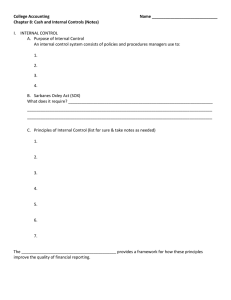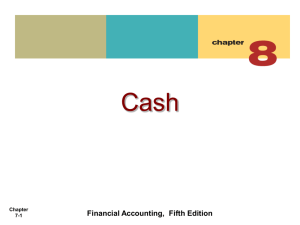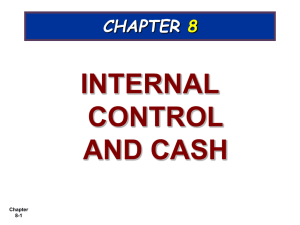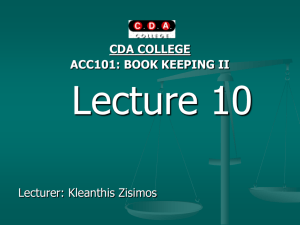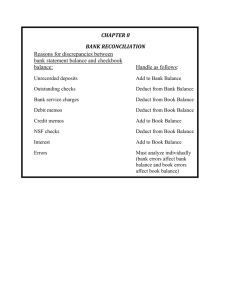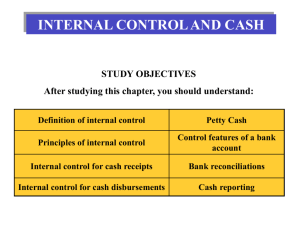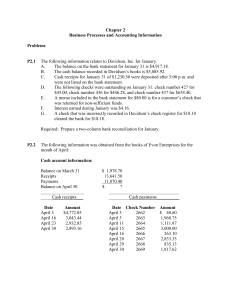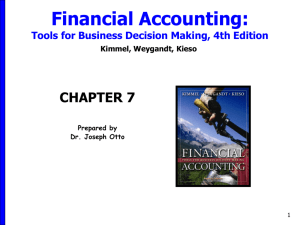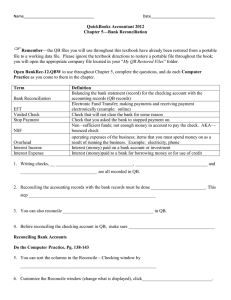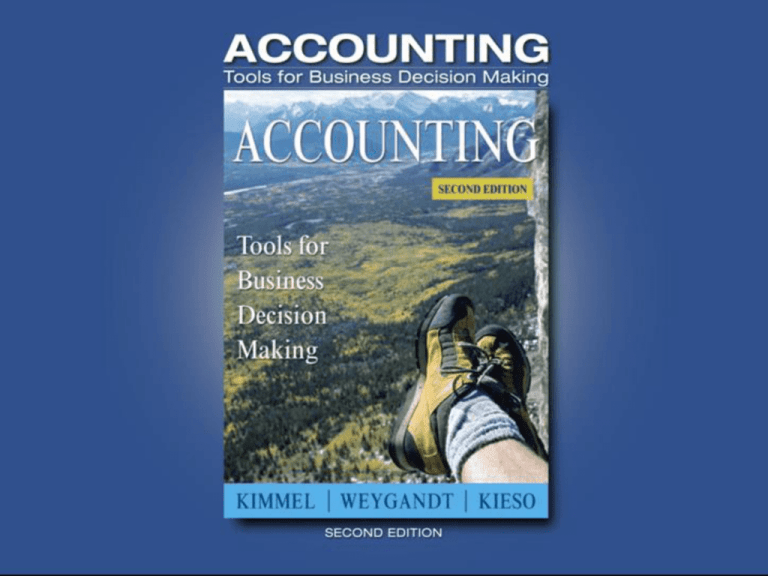
1
Chapter 7
INTERNAL CONTROL
AND CASH
2
CHAPTER 7
INTERNAL CONTROL AND CASH
After studying this chapter, you should be
able to:
Identify the principles of internal control.
Explain the applications of internal control to
cash receipts.
Explain the applications of internal control to
cash disbursements.
Prepare a bank reconciliation.
Explain the reporting of cash.
Discuss the basic principles of cash
management.
Identify the primary elements of a cash
budget.
3
1
PRINCIPLES OF INTERNAL
CONTROL
11
Internal control
Safeguards an organization’s
assets from
Employee theft, robbery,
unauthorized use
Enhances the accuracy and
reliability of accounting records
Risk of errors and irregularities
4
PRINCIPLES OF INTERNAL
CONTROL
5
PRINCIPLES OF INTERNAL CONTROL
Establishment of
responsibility:
most effective when
only one person is
responsible for a
given task
Segregation of
duties:
the work of one
employee should
provide a reliable
basis for
evaluating the
work of
another employee
PRINCIPLES OF INTERNAL CONTROL
Documentation procedures:
documents provide evidence that
transactions and events have
occurred
7
Physical, Mechanical, and
Electronic Controls
Independent Internal Verification
Independent Internal Verification
Rotating employee’s
duties and requiring
employees to take
vacations
10
Limitations of Internal
Controls
Cost/Benefit - cost of establishing
procedure should not exceed expected
benefit
Human element - fatigue, carelessness,
indifference
Collusion - two or more individuals who
work together to get around controls
Size of business
11
Review
a.
b.
c.
d.
Segregation of duties means?
Rotating employee duties and
requiring vacations.
Reviewing, comparing and reconciling
information from two sources.
The responsibility for related activities
should be assigned to different
individuals.
Physical separation of employees from
each other.
12
Cash consists of...
coins
currency
checks
money orders
money on hand
deposits in bank
13
Petty Cash Fund
is a cash fund used to pay relatively small amounts
14
USE OF A BANK
The use of a bank
minimizes the amount of currency that
must be kept on hand
contributes significantly to good internal
control over cash.
A “double” record of cash is
maintained, one by the
company, one by the bank.
These two accounts must
be reconciled.
15
Bank Statement
a copy of the
bank’s records
sent to the
customer for
periodic review.
Bank
Statement
shows
•check &
other debits
•deposits &
other credits
•daily cash
balance
16
4
11
RECONCILING THE BANK
ACCOUNT
Reconciliation
is necessary as the balance per bank
and balance per books are seldom in
agreement due to time lags and errors
A bank reconciliation
should be prepared by an employee
who has no other responsibilities
pertaining to cash
17
RECONCILING THE
BANK ACCOUNT
Steps in preparing a bank reconciliation:
Determine deposits in transit
Determine outstanding checks
Note any errors discovered
Trace bank memoranda to the records
Each reconciling item used in determining the
“Adjusted cash balance per books” should be
recorded by the depositor with an adjusting
entry
18
BANK RECONCILIATION
Terms
Deposits in transit - deposits recorded by the
depositor that have not been recorded by the
bank.
Outstanding checks - checks issued and recorded
by the company that have not been paid by the
bank.
NSF check - a check that is not paid by the bank
because of insufficient funds in the customer’s
bank account.
Adjusted balance - same as true cash balance,
correct cash balance
20
BANK RECONCILIATION
21
ENTRIES FROM BANK
RECONCILIATION
GENERAL JOURNAL
Date
Apr. 30
Account Titles and Explanation
Cash
Miscellaneous Expense
Notes Receivable
Interest Revenue
(To record collection of notes
receivable by bank)
Debit
Credit
1035
15
1000
50
Collection of Note Receivable This entry involves four
accounts. Interest of $50 has not been accrued and the
collection fee is charged to Miscellaneous Expense.
22
ENTRIES FROM BANK
RECONCILIATION
GENERAL JOURNAL
Date
Apr. 30
Account Titles and Explanation
Cash
Accounts Payable — Andrea
Company
(To correct error in recording
check No. 443)
Debit
Credit
36
36
Book Error An examination of the cash disbursements
journal shows that check No. 443 was a payment on
account to Andrea Company, a supplier. The check, with
a correct amount of $1,226.00, was recorded at $1,262.00.
23
ENTRIES FROM BANK
RECONCILIATION
GENERAL JOURNAL
Date
Apr. 30
Account Titles and Explanation
Accounts Receivable — J. R. Baron
Cash
(To record NSF check)
Debit
Credit
425.60
425.60
NSF Check An NSF check becomes an
accounts receivable to the depositor.
24
ENTRIES FROM BANK
RECONCILIATION
GENERAL JOURNAL
Date
Apr. 30
Account Titles and Explanation
Miscellaneous Expense
Cash
(To record charge for printing
company checks)
Debit
Credit
30
30
Bank Service Charges Check printing charges (DM) and other
bank service charges (SC) are debited to Miscellaneous
Expense because they are usually nominal in amount.
25
6
11
Basic Principles of Cash
Management
Copyright © 2008 John Wiley & Sons, Inc. All rights
reserved. Reproduction or translation of this work
beyond that named in Section 117 of the United States
Copyright Act without the express written consent of the
copyright owner is unlawful. Request for further
information should be addressed to the Permissions
Department, John Wiley & Sons, Inc. The purchaser
may make back-up copies for his/her own use only and
not for distribution or resale. The Publisher assumes no
responsibility for errors, omissions, or damages, caused
by the use of these programs or from the use of the
information contained herein.
27

